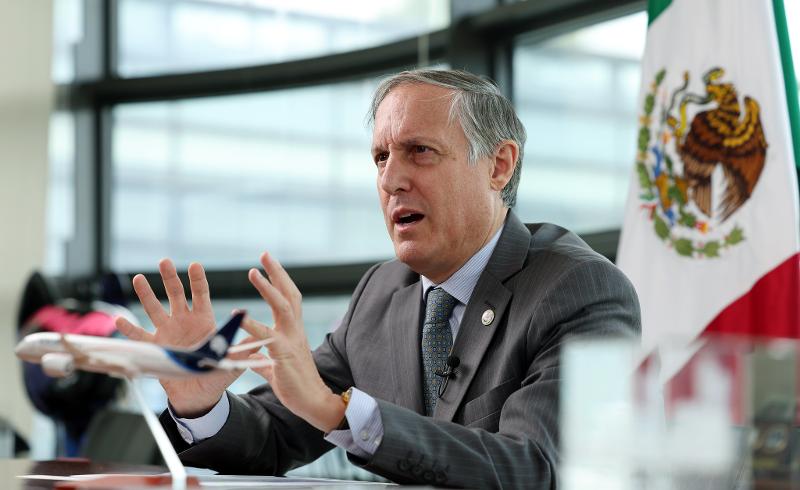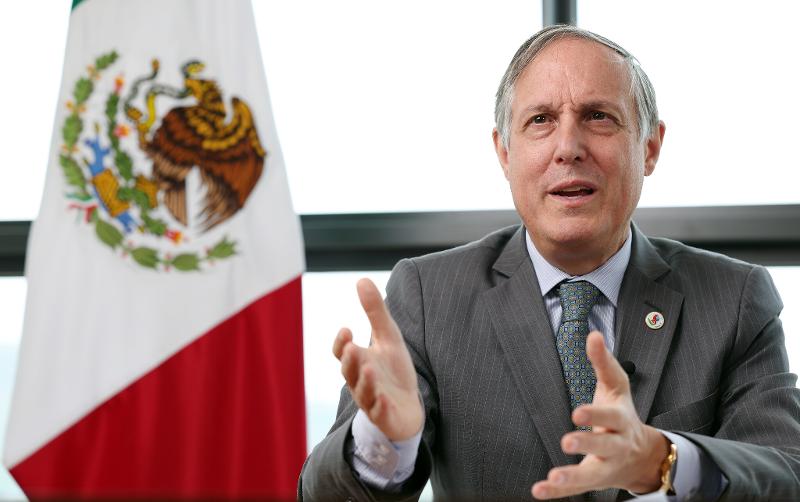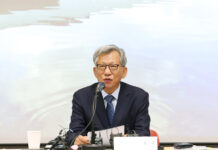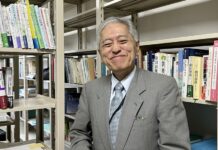| This year, Korea marks the 60th anniversary of diplomatic relations with 15 Latin American countries — Mexico, Argentina, Colombia, Chile, Ecuador, Guatemala, the Dominican Republic, Panama, Costa Rica, Paraguay, El Salvador, Honduras, Jamaica, Nicaragua and Haiti. In 1962, Korea began its path toward modernization through ties with just 27 countries, but in the same year, it forged formal relations with 15 of the 20 Latin American nations achieving independence at the time. Korea.net explores the direction of cooperation between Korea and its Latin American partners through interviews with ambassadors from the region. |

Mexican Ambassador to Korea Bruno Figueroa Fischer on May 19 at his embassy in Seoul’s Jongno-gu District called the launch of direct flights between Korea and Mexico the most meaningful outcome of 60 years of bilateral relations.
By Yoon Sojung and Anais Faure with contribution from Lee Yu Rim
Photos = Jeon Han
Video = Kim Sunjoo and Lee Jun Young
Seoul | May 19, 2022
Mexican Ambassador to Korea Bruno Figueroa Fischer calls the opening of direct flights between Korea and Mexico the most significant outcome of bilateral relations, which mark their 60th anniversary this year.
In an interview with Korea.net on May 19 at his embassy in Seoul’s Jongno-gu District, he said the direct flights were a “game changer” in two-way ties.
“Now, it takes only 15 hours from Incheon International Airport to Mexico City,” he added.
Before the opening of the route, it took about 20 hours by plane from Korea to Mexico via stopover in Los Angeles or San Francisco.
“Since the beginning of Korean immigration to Mexico on the Yucatan Peninsula in 1905, the people of both countries have learned about each other,” he said. “Even in the time of the COVID-19 pandemic, bilateral trade did grow.”
“This shows the importance of which both countries consider each other in the Asian and North American regions.”
The ambassador said the sacrifices of about 100,000 soldiers of Mexican descent in the Korean War form the foundation for developing bilateral ties.
Since assuming his post in Korea in May 2017, the diplomat has taken up the hobby of taking photos of the country’s beautiful scenery. His pictures were displayed from June 14-21 in the photo exhibition titled “#ATribute2Korea” at a gallery in the capital’s Seongbuk-gu District, expressing his gratitude for his life in Korea over the last five years.
Ambassador Figueroa previously served as deputy permanent representative to the Organisation for Economic Co-operation and Development (OECD) from 2007-10. Before coming to Korea, he was chief of staff at the Mexican Agency for International Development Cooperation (2010-13), director general for technical and scientific cooperation (2013-15); and director general of technical, scientific and financial cooperation between Mexico and Central America and the Caribbean (2015–17).
The following are excerpts from the interview.
– This year marks the 60 anniversary of diplomatic relationship between Korea and Mexico. What do you feel was the most crucial task for developing ties over this period?
I would say the opening of direct flights in 2017. The launch of the flights was a game changer in bilateral ties. Now, it takes 15 hours from Incheon International Airport to Mexico City. Narrowing the gap between both sides significantly boosted the bilateral relationship.
Before the 1960s, the two countries had no exchanges and didn’t have enough knowledge about each other. But they achieved remarkable developments, and now the volume of bilateral trade exceeds USD 25 billion annually. Mexico is the first Latin American country Korea forged trade relations with and Korea is also Mexico’s third-largest trading partner, trailing only the U.S. and China.
– What event to mark this anniversary does the embassy consider a must-see?
The exhibition “Aztecs” at the National Museum of Korea is a must-see. Slated from May 3 through Aug. 28, this is the first exhibition in Korea that features the Aztec culture and civilization of Mexico. It shows more than 200 artifacts, with some of them even never shown to the public in Mexico before. We are also planning to host about 30 related events to mark the diplomatic milestone in various sectors.
– What progress have you seen in bilateral cooperation in health and medicine amid the COVID-19 pandemic?
In the early stage of the pandemic, Korea was an Asian country affected by the coronavirus. We took a closer look at how the Korean government and its people handled the situation and realized that sharing experiences with Korea is very important. In 2020, the Mexican government asked Korea to share exemplary cases of COVID-19 responses. In return, we hosted related webinars and had exchanges of medical experts and other related personnel. We also received donations of COVID-19 treatments, vaccines and protection masks from the Korean government, companies and people. Recently, we received donations of vaccines for children from the Korean government.
– Korea and Mexico resumed free trade negotiations earlier this year. What progress has been made?
A few years ago, the two countries held free trade negotiations but later stopped because of obstacles on both sides. On March 1 this year, the trade ministers of both countries officially announced the resumption of such negotiations. This time, I hope that the negotiations bear a fruitful outcome, help both countries maintain a trade balance and supplement both economies by sector and deepen relations. Our two countries had active exchanges even without the (free trade agreement), but I hope that the deal can further bolster cooperation.
Despite the COVID-19 pandemic, the trade volume between both countries did grow. This proves how important they consider each other in the East Asia and North American regions. I also hope that both countries can strengthen cooperation in the fields of new mobility, hydrogen, electric vehicles and the environment.

Ambassador Figueroa said the sacrifices of 100,000 Mexican and Mexican American soldiers who fought in the Korean War form the foundation for the development of bilateral ties.
– In an interview with a Korean media outlet, you said Mexico can be a strong supporter of Korea. Why do you think so?
Both countries can become a strong supporter of each other. This is because we are middle powers that share common values and pursue the same direction in the international community. We protect free trade, democracy and human rights, and a rule-based international order. Based on such common ground, we work together closely in the United Nations and as members of the OECD. We also work together to maintain the international order as members of the five likeminded countries of MIKTA — Mexico, Indonesia, Korea, Turkey and Australia.
– What Mexican food or cultural item do you wish to introduce to people here?
I would like to tell Koreans about the history of 100,000 Mexican and Mexican American soldiers who fought in the Korean War. Most of them fought for peace on the Korean Peninsula under the flag of the U.N. as the American army, bringing their heart and soul to Korea. I believe their sacrifice have become the foundation for developments in the bilateral relationship. To highlight their history, a special exhibition titled “The Forgotten Soldiers of the Korean War” will be jointly held at the War Memorial of Korea in Seoul’s Yongsan-gu District from June 28 to Sept. 25.
The roots of bilateral relations go back to 1905, when Korean immigration to Mexico on the Yucatan Peninsula began. Today, about 15,000 Koreans live in Mexico, including the descendants of the first generation of Korean immigrants. They brought their food and culture to Mexico and we learned about Korea from them.
It seems Koreans love Mexican food and they are strongly interested in trying new Mexican dishes. Over the last five years, I found it interesting when a new Mexican restaurant opened in Korea. One day, we decided to count how many Mexican restaurants are here and there were around 250.
Tacos are a world-famous dish and a must-have menu I wish to recommend to Koreans. Tacos are like a whole universe. The ingredients for tacos such as tortilla, meat, fish, vegetables, cheese and many sauces remind me of Korean banchan (side dishes) accompanying a Korean meal. I love bulgogi (grilled marinated beef) and how you eat bulgogi or Korean barbeque wrap in a lettuce leaf with other side dishes with your hands is quite similar to the way you enjoy tacos. I also recommend mixing both Korean and Mexican food. In particular, we discovered that it’s very tasty to have both beef tacos and kimchi as they really go well together. I hope that many people enjoy tacos in a variety of ways and explore the food and culture of both countries. Explore it, taste it and you’ll love it.























